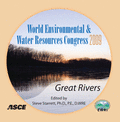Codorus Creek Restoration — A Case Study for the Chesapeake Bay
Publication: World Environmental and Water Resources Congress 2009: Great Rivers
Abstract
Healthy streams have the physical characteristics and chemical water quality to support healthy and diverse populations of organisms. The Codorus Creek, a tributary to the Susquehanna River, which eventually drains to the Chesapeake Bay, is being restored in several locations. Penn State University (York and Harrisburg campuses) is evaluating the effectiveness of the state-funded restoration activities. We examine the current pollutant loadings of two branches of this stream in conjunction with land use practices, particularly agriculture and wastewater treatment plants. Fish, macroinvertebrates, and periphyton are routinely sampled. Streamwater sampling for water chemistry analyses occurs during both baseflow and storm event conditions. Restored sites are being compared to both impaired and control sites to determine whether restoration has any significant reduction in a pollutant's load. Preliminary results indicate that the southern branch has greater impairment than the eastern branch. The southern branch impaired site showed greater annual mean loads of total nitrogen and total phosphorus, a macroinvertebrate community dominated by pollution tolerant organisms, and a greater number of fish with parasitic diseases. All sources contributing to the total nitrogen load to Codorus Creek have not been identified. Although restoration activities may decrease pollutant loads, such as as suspended solids, restoration is not believed to be effective in decreasing nitrogen loads. Nitrogen is found more readily in the aqueous phase (streamwater) rather than adsorbed to sediment particles. Therefore, more effective ways to remove nitrogen in water is to decrease or eliminate the source or to treat the streamwater directly. Further monitoring and comparison of restored sites to control and impaired sites are needed. In addition, future work on the toxicity of the legacy sediments has been proposed.
Get full access to this article
View all available purchase options and get full access to this chapter.
Information & Authors
Information
Published In
Copyright
© 2009 American Society of Civil Engineers.
History
Published online: Apr 26, 2012
ASCE Technical Topics:
- Bays
- Case studies
- Chemical compounds
- Chemical elements
- Chemicals
- Chemistry
- Coastal engineering
- Coasts, oceans, ports, and waterways engineering
- Design (by type)
- Ecological restoration
- Ecosystems
- Engineering fundamentals
- Environmental engineering
- Load factors
- Methodology (by type)
- Nitrogen
- Nutrient pollution
- Pollution
- Research methods (by type)
- River engineering
- Rivers and streams
- Structural design
- Water and water resources
- Water pollution
Authors
Metrics & Citations
Metrics
Citations
Download citation
If you have the appropriate software installed, you can download article citation data to the citation manager of your choice. Simply select your manager software from the list below and click Download.
